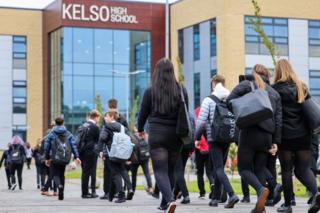What virus lessons can rest of the UK learn from Scotland?
The return of schools in England and Wales this week, after lockdown and the summer holidays, has been called a pivotal moment. As children start to mix, there is concern coronavirus transmission rates will begin to surge.
In Scotland, pupils have been back since the middle of August. So what can the rest of the UK learn from its example?
1. Infections rise, but not surge
Fears that the return to class would trigger a sharp increase in transmission have not materialised – at least not yet.
Within days of returning to their desks, some pupils tested positive for the virus. But Scotland’s First Minister Nicola Sturgeon then pointed out they had contracted it outside of school itself. A large house party in North Lanarkshire was suspected of triggering a cluster of cases involving pupils from four different high schools.
In Dundee, an additional support needs school had to close after a cluster of cases. But the majority of these were among adult teaching and support staff.
While some primary schools had to ask a whole class to self-isolate, only a handful of schools have required a temporary closure for deep cleaning.
A few days ago the first cases of transmission within school premises were identified at two schools in Glasgow. It wasn’t an unexpected development, says Scotland’s national clinical director, Prof Jason Leitch. Such clusters would be treated the same as any other.
University of Edinburgh public health expert Prof Devi Sridhar, who advises the Scottish government, says the key is keeping the numbers low in the general population.
“Schools are not super-spreader events but they’re not bubbles either,” she said. “They are a mirror of what’s happening in society.”
2. Cautious parents put a strain on testing
Almost a fortnight after most schools returned, Scotland was hit by a spike in demand for Covid testing. The reasons aren’t fully understood, but it’s suspected that other viruses, like the common cold, are on the rise. It could be parents are cautious and booking a test at the first sign of a “sniffle”.
The latest advice for parents points out a “runny nose”does not in itself require a test or self-isolation. Only the main Covid symptoms – continuous cough, fever, or change in the sense of taste or smell – require action.
Demand for testing has increased “significantly” since pupils returned, says Ms Sturgeon. But few come back positive. In the week to 30 August, only 37 individuals under the age of 18 tested positive, out of nearly 30,000 who were tested.
3. Pupil absences will rise
By the second half of August all schools in Scotland were back. Then absences started to rise, with attendance dropping to 85% at one point. But Covid wasn’t to blame.
Attendance in Scottish schools
It could be coronavirus has led parents to keep their children off school more, even if they don’t tell the school that. Covid-related absences – such as a positive test, showing symptoms or self-isolation – were running at only about 3% with about four times as many students off school for other reasons.
Absenteeism is an “emerging issue”, says Jim Thewliss, from School Leaders Scotland, which represents senior school staff.
“Parents are taking a fail-safe approach,” he says. “They’re thinking my child is not well, we’re going to get a test and keep them off in the meantime.”
He believes schools will have to find better ways of supporting learning for children who are being kept home.
4. Guidance may need to evolve
There has already been one big change in the rules – on the use of face coverings. Only after going back, were pupils told to wear masks in corridors, communal areas and on school transport. The official reason was new World Health Organization advice based on evidence that teenagers transmit the virus in a similar way to adults.
But in the previous week pictures had also emerged on social media of pupils packed like sardines in school corridors as they moved between classes.
Similar advice was soon issued in Northern Ireland and, to a lesser extent, in England.
In Scotland the Education Recovery Group, bringing together government, the teaching profession, councils and parents, has been meeting regularly since April, providing a forum where issues can be raised.
“It would be disingenuous to say everybody has been happy but we’ve at least been party to the decisions that have been taken,” says Mr Thewliss.
Ahead of recent meetings, stakeholders have listed what’s gone well, what’s not going well – and identified emerging problems. Mr Thewliss says practical subjects like drama, music or PE have encountered some difficulties which he expects to be addressed shortly in updated guidance. Schools are also set to be issued with new flow charts to help them address issues quickly.
5. Hand sanitiser can strain tight budgets
With so much emphasis being placed on hand hygiene, it’s not surprising schools are using a lot of hand sanitiser. The bill for protective equipment is for the most part being picked up by councils, which have been given extra funding from the Scottish government.
But there has been some confusion, with one head teacher in the west of Scotland complaining their school was facing additional costs of about £20,000.
Another teacher said they knew of cases where schools had been urged to be more sparing in the use of hand sanitiser.
School Leaders Scotland says while there has been some variation across the country, schools have been given supplies of PPE and it’s an improving picture.
- FACE MASKS: When do I need to wear one?
- SCHOOLS: What will happen if children catch coronavirus?
- TEST AND TRACE: How does it work?
- TESTING: What tests are available?
- SYMPTOMS: What are they and how to guard against them?
- Scotland Education
- Coronavirus lockdown measures
- Schools
- Coronavirus pandemic
Source: Read Full Article



